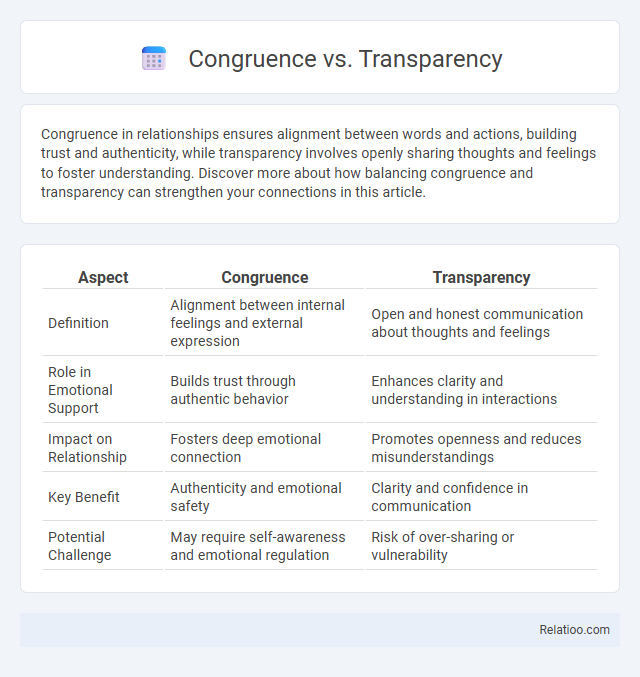Congruence in relationships ensures alignment between words and actions, building trust and authenticity, while transparency involves openly sharing thoughts and feelings to foster understanding. Discover more about how balancing congruence and transparency can strengthen your connections in this article.
Table of Comparison
| Aspect | Congruence | Transparency |
|---|---|---|
| Definition | Alignment between internal feelings and external expression | Open and honest communication about thoughts and feelings |
| Role in Emotional Support | Builds trust through authentic behavior | Enhances clarity and understanding in interactions |
| Impact on Relationship | Fosters deep emotional connection | Promotes openness and reduces misunderstandings |
| Key Benefit | Authenticity and emotional safety | Clarity and confidence in communication |
| Potential Challenge | May require self-awareness and emotional regulation | Risk of over-sharing or vulnerability |
Understanding Congruence: Definition and Importance
Understanding congruence involves recognizing the alignment between your values, beliefs, and actions, which fosters authentic communication and trust in relationships. Transparency refers to openly sharing information and intentions, while consistency ensures your behavior remains steady across different situations. Your ability to maintain congruence enhances personal integrity, improves decision-making, and strengthens connections by reducing misunderstandings and conflicts.
Defining Transparency in Communication
Transparency in communication involves openly sharing information, intentions, and feelings to build trust and clarity between parties. Unlike congruence, which emphasizes alignment between verbal and nonverbal messages, transparency prioritizes honesty and openness regardless of communication style. Your ability to practice transparency enhances mutual understanding and fosters stronger relationships by reducing misunderstandings and ambiguity.
Key Differences: Congruence vs Transparency
Congruence refers to the alignment between an organization's values, actions, and communication, ensuring consistency and authenticity in all interactions. Transparency involves openly sharing information, decisions, and processes to build trust and accountability with stakeholders. The key difference is that congruence emphasizes internal consistency and integrity, while transparency focuses on external openness and information accessibility.
The Role of Congruence in Building Trust
The role of congruence in building trust centers on the alignment between words and actions, which fosters credibility and reliability in interpersonal and organizational relationships. Transparency enhances this trust by openly sharing information and intentions, allowing stakeholders to verify congruence and reduce uncertainty. Together, congruence and transparency form a foundation for authentic communication, reinforcing trust and long-term commitment.
How Transparency Impacts Decision-Making
Transparency enhances decision-making by providing clear access to relevant information, which improves trust and accountability among stakeholders. It reduces uncertainty and biases, enabling more informed and objective choices. Organizations that prioritize transparency often experience higher collaboration and faster consensus-building, leading to more effective outcomes compared to relying solely on congruence or alignment of values.
Benefits of Practicing Congruence in Relationships
Practicing congruence in relationships fosters trust by promoting genuine self-expression and aligning words with actions, which reduces misunderstandings and enhances emotional intimacy. Transparency involves openly sharing thoughts and feelings, but without congruence, it may lead to confusion if internal values are inconsistent with communicated messages. Prioritizing congruence ensures consistent communication and authentic connections, resulting in stronger, healthier relationships built on reliability and mutual respect.
Potential Pitfalls of Excessive Transparency
Excessive transparency can lead to information overload, causing confusion and decision fatigue that undermine effective communication. While congruence ensures alignment between your actions and values, too much transparency might expose sensitive information, risking privacy and strategic advantage. Balancing transparency with congruence safeguards trust without compromising your organization's integrity or competitive edge.
Achieving Balance: Integrating Congruence and Transparency
Achieving a balance between congruence and transparency requires aligning your organization's values and actions while openly communicating intentions and decisions. Maintaining congruence ensures authenticity and trustworthiness, whereas transparency fosters openness and accountability with stakeholders. Your ability to integrate both concepts strengthens credibility and builds lasting relationships.
Real-World Examples: Congruence vs Transparency in Action
In organizational leadership, congruence refers to alignment between values, actions, and communication, as seen in Patagonia's commitment to environmental sustainability reflected in its marketing and business practices. Transparency involves openly sharing information and decision-making processes, exemplified by Buffer's public salary formulas and company financials. Companies balancing congruence and transparency build trust by ensuring their internal behaviors match their external messages while openly disclosing relevant information to stakeholders.
Best Practices for Fostering Authenticity and Openness
Fostering authenticity and openness requires balancing congruence, transparency, and consistency in your communication and actions. Congruence ensures your words align with your values and behavior, building trust, while transparency involves openly sharing relevant information to maintain clarity and reduce misunderstandings. Prioritize regular feedback, active listening, and vulnerability to create an environment where your authenticity encourages others to engage genuinely and confidently.

Infographic: Congruence vs Transparency
 relatioo.com
relatioo.com